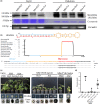Fol-milR1, a pathogenicity factor of Fusarium oxysporum, confers tomato wilt disease resistance by impairing host immune responses
- PMID: 33960431
- PMCID: PMC8518127
- DOI: 10.1111/nph.17436
Fol-milR1, a pathogenicity factor of Fusarium oxysporum, confers tomato wilt disease resistance by impairing host immune responses
Abstract
Although it is well known that miRNAs play crucial roles in multiple biological processes, there is currently no evidence indicating that milRNAs from Fusarium oxysporum f. sp. lycopersici (Fol) interfere with tomato resistance during infection. Here, using sRNA-seq, we demonstrate that Fol-milR1, a trans-kingdom small RNA, is exported into tomato cells after infection. The knockout strain ∆Fol-milR1 displays attenuated pathogenicity to the susceptible tomato cultivar 'Moneymaker'. On the other hand, Fol-milR1 overexpression strains exhibit enhanced virulence against the resistant cultivar 'Motelle'. Several tomato mRNAs are predicted targets of Fol-milR1. Among these genes, Solyc06g007430 (encoding the CBL-interacting protein kinase, SlyFRG4) is regulated at the posttranscriptional level by Fol-milR1. Furthermore, SlyFRG4 loss-of-function alleles created using CRISPR/Cas9 in tomato ('Motelle') exhibit enhanced disease susceptibility to Fol, further supporting the idea that SlyFRG4 is essential for tomato wilt disease resistance. Notably, our results using immunoprecipitation with specific antiserum suggest that Fol-milR1 interferes with the host immunity machinery by binding to tomato ARGONAUTE 4a (SlyAGO4a). Furthermore, virus-induced gene silenced (VIGS) knock-down SlyAGO4a plants exhibit reduced susceptibility to Fol. Together, our findings support a model in which Fol-milR1 is an sRNA fungal effector that suppresses host immunity by silencing a disease resistance gene, thus providing a novel virulence strategy to achieve infection.
Keywords: Fusarium oxysporum f. sp. lycopersici; immunity response; plant-pathogen interactions; resistant gene; tomato wilt disease; trans-kingdom miRNA.
© 2021 The Authors. New Phytologist © 2021 New Phytologist Foundation.
Figures





Comment in
-
One microRNA-like small RNA - two silencing pathways?New Phytol. 2021 Oct;232(2):464-467. doi: 10.1111/nph.17652. Epub 2021 Aug 28. New Phytol. 2021. PMID: 34453746 No abstract available.
Similar articles
-
Host RNAi-mediated silencing of Fusarium oxysporum f. sp. lycopersici specific-fasciclin-like protein genes provides improved resistance to Fusarium wilt in Solanum lycopersicum.Planta. 2024 Mar 3;259(4):79. doi: 10.1007/s00425-024-04360-y. Planta. 2024. PMID: 38431538
-
Identification of I-7 expands the repertoire of genes for resistance to Fusarium wilt in tomato to three resistance gene classes.Mol Plant Pathol. 2016 Apr;17(3):448-63. doi: 10.1111/mpp.12294. Epub 2015 Sep 18. Mol Plant Pathol. 2016. PMID: 26177154 Free PMC article.
-
An integrated analysis of mRNA and sRNA transcriptional profiles in tomato root: Insights on tomato wilt disease.PLoS One. 2018 Nov 5;13(11):e0206765. doi: 10.1371/journal.pone.0206765. eCollection 2018. PLoS One. 2018. PMID: 30395631 Free PMC article.
-
Breeding for Resistance to Fusarium Wilt of Tomato: A Review.Genes (Basel). 2021 Oct 23;12(11):1673. doi: 10.3390/genes12111673. Genes (Basel). 2021. PMID: 34828278 Free PMC article. Review.
-
Fusarium oxysporum f. sp. lycopersici causal agent of vascular wilt disease of tomato: Biology to diversity- A review.Saudi J Biol Sci. 2019 Nov;26(7):1315-1324. doi: 10.1016/j.sjbs.2019.06.002. Epub 2019 Jun 4. Saudi J Biol Sci. 2019. PMID: 31762590 Free PMC article. Review.
Cited by
-
Cross-Kingdom RNA Transport Based on Extracellular Vesicles Provides Innovative Tools for Plant Protection.Plants (Basel). 2024 Sep 27;13(19):2712. doi: 10.3390/plants13192712. Plants (Basel). 2024. PMID: 39409582 Free PMC article. Review.
-
Extracellular vesicles: cross-organismal RNA trafficking in plants, microbes, and mammalian cells.Extracell Vesicles Circ Nucl Acids. 2023 Jun;4(2):262-282. doi: 10.20517/evcna.2023.10. Epub 2023 Jun 19. Extracell Vesicles Circ Nucl Acids. 2023. PMID: 37575974 Free PMC article.
-
Trans-Kingdom RNA Dialogues: miRNA and milRNA Networks as Biotechnological Tools for Sustainable Crop Defense and Pathogen Control.Plants (Basel). 2025 Apr 20;14(8):1250. doi: 10.3390/plants14081250. Plants (Basel). 2025. PMID: 40284138 Free PMC article. Review.
-
Understanding the Dynamics of Blast Resistance in Rice-Magnaporthe oryzae Interactions.J Fungi (Basel). 2022 May 30;8(6):584. doi: 10.3390/jof8060584. J Fungi (Basel). 2022. PMID: 35736067 Free PMC article. Review.
-
Cross-kingdom small RNA communication between plants and fungal phytopathogens-recent updates and prospects for future agriculture.RNA Biol. 2023 Jan;20(1):109-119. doi: 10.1080/15476286.2023.2195731. RNA Biol. 2023. PMID: 36988190 Free PMC article. Review.
References
-
- Asai S, Shirasu K. 2015. Plant cells under siege: plant immune system versus pathogen effectors. Current Opinion in Plant Biology 28: 1–8. - PubMed
-
- Atkinson NJ, Urwin PE. 2012. The interaction of plant biotic and abiotic stresses: from genes to the field. Journal of Experimental Botany 63: 3523–3543. - PubMed
-
- Baulcombe D. 2004. RNA silencing in plants. Nature 431: 356–363. - PubMed
Publication types
MeSH terms
Substances
Supplementary concepts
LinkOut - more resources
Full Text Sources
Other Literature Sources
Miscellaneous

